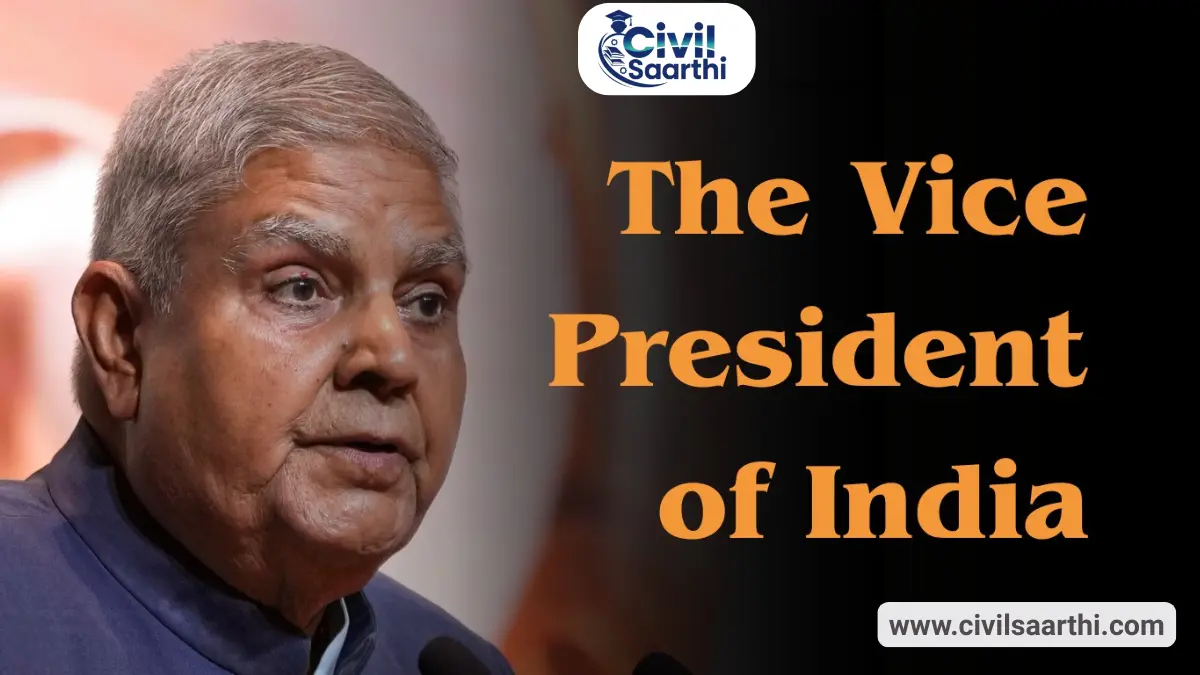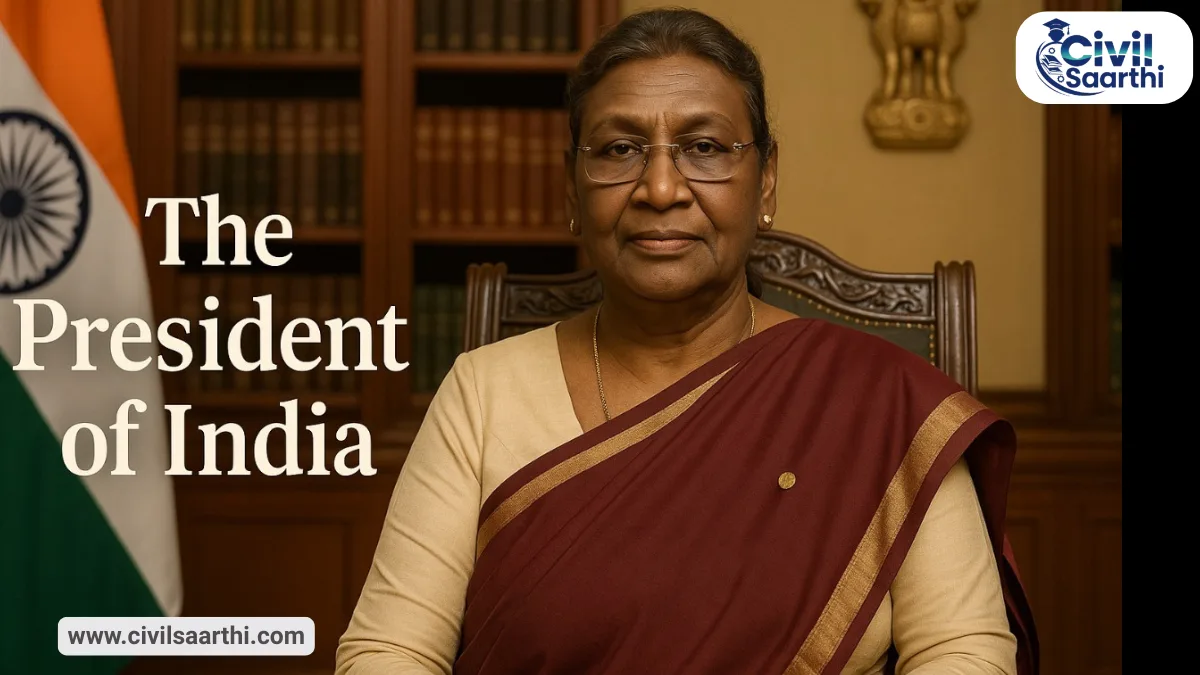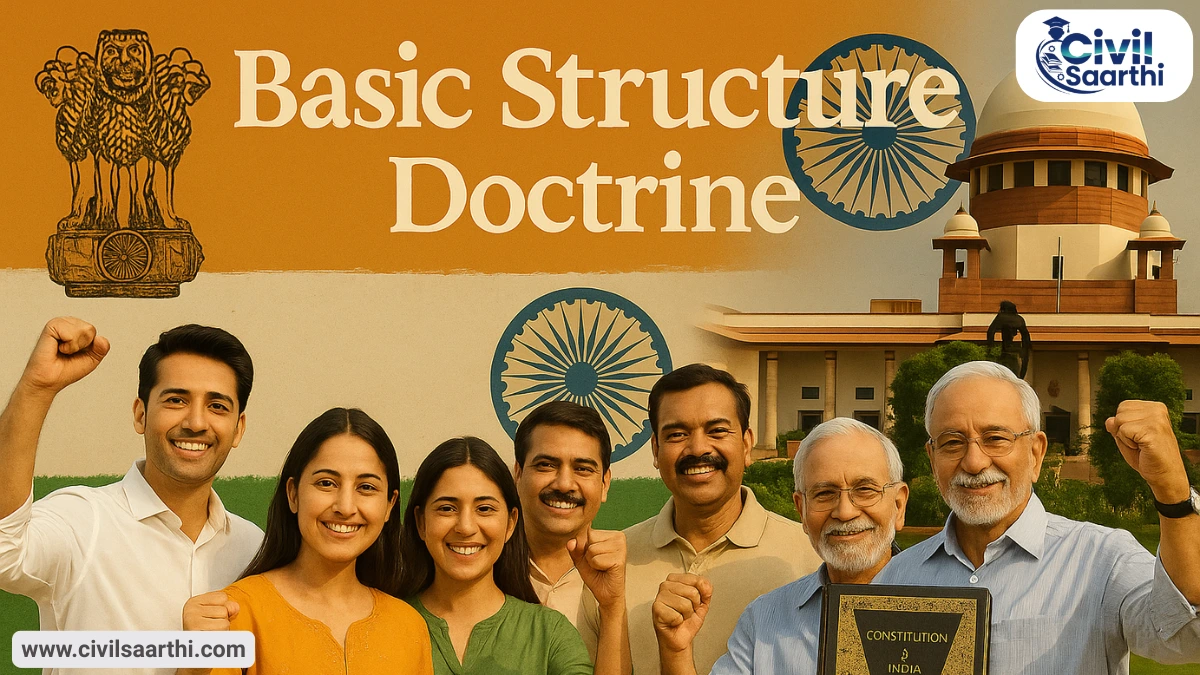The Vice-President of India holds the second-highest constitutional office and is a key component of India’s federal parliamentary democracy. Though largely seen as a ceremonial post, the Vice-President performs crucial legislative and constitutional functions. These include chairing the Rajya Sabha, acting as President in specific contingencies, and ensuring stability in governance. For UPSC aspirants, a clear understanding of this office is important for both Prelims and Mains.
Constitutional Provisions (Articles 63 to 70)
The office of the Vice-President is constitutionally mandated and is covered under Articles 63 to 70 of the Indian Constitution. These provisions define the role, election, eligibility, term, and removal procedure of the Vice-President, making the office a vital part of India’s constitutional design.
| Article | Subject Matter |
|---|---|
| Article 63 | Mandates the office of the Vice-President |
| Article 64 | Vice-President as ex-officio Chairman of Rajya Sabha |
| Article 65 | Vice-President to act as President in contingencies |
| Article 66 | Election of the Vice-President |
| Article 67 | Term and removal process |
| Article 68 | Election to fill vacancy |
| Article 69 | Oath or affirmation before taking office |
| Article 70 | Discharge of President’s functions in contingencies |
Election of the Vice-President (Article 66)
The Vice-President is elected through an indirect process that reflects India’s federal character. The system ensures representation of both elected and nominated members of Parliament but excludes state legislatures. The election is overseen by the Election Commission of India.
Key Features of Vice-Presidential Election:
- Electoral College: Includes members (elected and nominated) of both Lok Sabha and Rajya Sabha.
- Voting System: Proportional representation via Single Transferable Vote (STV).
- Mode: Secret ballot.
- Authority: Conducted by Election Commission of India.
- Exclusion: State Legislative Assemblies have no role.
- Notification: Issued under the Presidential and Vice-Presidential Elections Act, 1952.
Qualifications for Vice-President (Article 66(3))
The Constitution outlines essential qualifications to ensure the candidate possesses a basic understanding of legislative functions and loyalty to the nation. These qualifications mirror those for Rajya Sabha membership.
Constitutional Eligibility:
- Must be a citizen of India.
- Must have completed 35 years of age.
- Must be eligible for election to the Rajya Sabha.
- Must not hold any office of profit under Union, State, or local authority.
Oath or Affirmation (Article 69)
Before assuming office, the Vice-President is required to take an oath administered by the President. The oath signifies loyalty to the Constitution and a promise to discharge duties faithfully.
Contents of the Oath:
- True faith and allegiance to the Constitution.
- Faithful discharge of the duties of the office.
Term of Office and Re-election (Article 67)
The term of the Vice-President is five years, but they can be re-elected any number of times. The Constitution allows continuation beyond the term until a successor takes over.
| Provision | Details |
| Term | 5 years |
| Re-election | Allowed, unlimited times |
| Resignation | Submitted to the President |
| Continuation | Until successor assumes charge |
Conditions of Office
The Vice-President must maintain impartiality, especially while presiding over the Rajya Sabha. Conditions are imposed to ensure independence from executive interference.
Key Conditions:
- No Office of Profit: Cannot hold any other post with salary/remuneration.
- Official Residence: Entitled to a government residence.
- Emoluments: Receives salary as Chairman of Rajya Sabha, not as Vice-President.
- Resignation: Addressed to the President.
Vacancy and Succession (Article 68)
Vacancies can occur due to various reasons, and the Constitution provides a clear succession protocol. Timely elections must be held within a prescribed period.
Causes of Vacancy:
- Completion of term.
- Resignation.
- Removal.
- Death.
- Disqualification or ineligibility.
Succession:
- Acting President: Performs duties of the President during vacancy.
- Election Timeline: Must be held within 6 months of vacancy.
Removal Procedure for Vice- President of India (Article 67(b))
The removal process of the Vice-President is simpler than that of the President, as it does not involve impeachment. The Constitution prescribes a parliamentary resolution method.
Procedure:
- Initiation: Only in Rajya Sabha.
- Type of Majority: Effective majority (excluding vacancies).
- Lok Sabha Approval: Simple majority required.
- Notice Period: 14 days.
- Grounds: No specific grounds required.
Powers and Functions of Vice-President of India
While the executive role of the Vice-President is limited, the office plays a vital constitutional and legislative function. The primary function is to ensure order and functioning of the Rajya Sabha.
Functional Roles:
- Ex-officio Chairman of Rajya Sabha: Presides over sessions and maintains order.
- Disqualification Powers: Refers 10th Schedule cases to President.
- Acts as President: Discharges duties when office of President is vacant.
- No Regular Executive Powers: Only a stop-gap arrangement.
Comparison: Vice-President of India vs Vice-President of USA
Understanding the difference between Indian and U.S. Vice-Presidents is crucial for comparative constitutional studies. While both preside over the Upper House, their executive functions differ significantly.
| Feature | India | USA |
| Election | Indirect by Parliament | Direct (via Electoral College) |
| Powers | Legislative, ceremonial | Legislative + Executive |
| Role in Legislature | Chairman of Rajya Sabha | President of Senate |
| Succession | Acts as President temporarily | Becomes President permanently |
| Term | 5 years | 4 years |
Significance of the Vice-President
Despite being a non-executive authority, the Vice-President is indispensable in India’s constitutional framework. The office ensures continuity, neutrality, and legislative balance in the federal system.
Key Significance:
- Ensures Constitutional Continuity: Steps in for the President when necessary.
- Maintains Legislative Order: As Rajya Sabha Chairman.
- Symbol of Federalism: Represents entire Parliament.
- Non-Partisan Authority: Required to act neutrally in legislative matters.
Vice-Presidents of India: List & Tenure
This section presents a chronological list of Vice-Presidents of India since Independence. Knowing their tenure, background, and any role as Acting President is useful for both Prelims and Mains.
| No. | Vice-President | Term | Acting President (Y/N) | Background |
| 1 | Dr. S. Radhakrishnan | 1952–1962 | No | Philosopher, Academic |
| 2 | Dr. Zakir Husain | 1962–1967 | No | Educationist |
| 3 | V.V. Giri | 1967–1969 | Yes (1969) | Trade Union Leader |
| 4 | Gopal Swarup Pathak | 1969–1974 | No | Jurist |
| 5 | B.D. Jatti | 1974–1979 | Yes (1977) | Politician, Governor |
| 6 | Mohammad Hidayatullah | 1979–1984 | Yes (1982) | Chief Justice of India |
| 7 | R. Venkataraman | 1984–1987 | Yes (1987) | Lawyer, Politician |
| 8 | Shankar Dayal Sharma | 1987–1992 | No | Freedom Fighter, Governor |
| 9 | K.R. Narayanan | 1992–1997 | No | Diplomat, Academic |
| 10 | Krishan Kant | 1997–2002 | No | Scientist, Politician |
| 11 | Bhairon Singh Shekhawat | 2002–2007 | No | Politician |
| 12 | Mohammad Hamid Ansari | 2007–2017 | No | Diplomat, Academic |
| 13 | M. Venkaiah Naidu | 2017–2022 | No | Politician, Union Minister |
| 14 | Jagdeep Dhankhar | 2022–2025 | No | Advocate, Governor |
Vice-President as Acting President: Case Studies
This section highlights specific instances where Vice-Presidents acted as President due to vacancy, resignation, or death of the incumbent. These cases underline the constitutional safety net provided by the Vice-President’s office.
Notable Case Studies:
- V.V. Giri (1969): Acted as President following Zakir Husain’s death; later resigned to contest Presidential election.
- B.D. Jatti (1977): Became Acting President after Fakhruddin Ali Ahmed’s death.
- Mohammad Hidayatullah (1982): Served briefly as Acting President during Zail Singh’s foreign tour.
- R. Venkataraman (1987): Assumed role of Acting President when Zail Singh’s term ended before the new President assumed office.
Judicial Interpretations & Supreme Court Cases
The judiciary has played a pivotal role in clarifying the constitutional position of the Vice-President, especially concerning powers during presidential vacancies and election disputes.
Key Cases:
- UPSC vs P.V. Narasimha Rao Case (1991): Upheld immunity of MPs and clarified constitutional protections.
- Special Reference No. 1 of 1974: Clarified powers of acting President and Vice-President during vacancy.
- R.C. Cooper vs Union of India (1970): Though primarily a bank nationalization case, it reinforced the sanctity of constitutional posts.
Vice-President: Challenges & Criticisms
While the office is constitutionally vital, it faces criticisms regarding relevance, effectiveness, and political neutrality. The ceremonial nature has sparked debates on whether reforms are needed.
Common Criticisms:
- Ceremonial Role: Lacks independent executive powers.
- Political Appointments: Often filled by party loyalists, risking neutrality.
- Limited Visibility: Lesser-known public role compared to President.
- Overlap with Rajya Sabha Chairmanship: May lead to political biases in legislative proceedings.
Way Forward
The role of the Vice-President, though often viewed as ceremonial, holds great constitutional relevance in maintaining legislative balance and democratic continuity. To enhance its effectiveness, reforms could focus on clearer delineation of powers, especially during acting presidency. Strengthening the independence of the Rajya Sabha Chair and codifying conventions related to succession can further institutionalize the office. Encouraging non-partisan appointments and increasing transparency in election procedures will help preserve the dignity and neutrality of this high office in India’s parliamentary democracy.
UPSC Prelims PYQs Related to Vice-President of India
Who among the following have held the office of the Vice President of India? [2008]
1. Mohammad Hidayatullah
2. Fakhruddin Ali Ahmed
3. Neelam Sanjiva
4. Shankar Dayal Sharma
Select the correct answer using the code given below:
a) 1, 2, 3 and 4 b) 1 and 4 only
c) 2 and 3 only d) 3 and 4 only
Ans b
The resolution for removing the Vice-President of India can be moved in the: [2004]
a) Lok Sabha alone
b) Either House of Parliament
c) Joint Sitting of Parliament
d) Rajya Sabha alone
Ans d
Vice- President of India FAQs
Q1. What is the term of the Vice-President of India?
A: Five years; re-election is allowed.
Q2. Who elects the Vice-President of India?
A: An electoral college of both elected and nominated members of Parliament.
Q3. Can the Vice-President act as President?
A: Yes, during the vacancy or absence of the President.
Q4. Is impeachment involved in the removal of the Vice-President?
A: No. A resolution passed by Rajya Sabha and agreed by Lok Sabha is sufficient.
Q5. Does the Vice-President draw a salary?
A: Yes, but as Chairman of Rajya Sabha, not for being Vice-President.
Q6. What are the qualifications for contesting the Vice-Presidential election?
A: Citizen of India, 35 years of age, eligible for Rajya Sabha.
Q7. How is the Vice-President different from the US counterpart?
A: The Indian VP has limited executive powers, while the U.S. VP has direct succession and significant executive authority.







